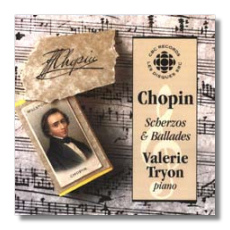
The Internet's Premier Classical Music Source
Related Links
- Chopin Reviews
- Latest Reviews
- More Reviews
-
By Composer
-
Collections
DVD & Blu-ray
Books
Concert Reviews
Articles/Interviews
Software
Audio
Search Amazon
Recommended Links
Site News
 CD Review
CD Review
Frédéric Chopin

Scherzi & Ballades
- Scherzo #1 in B minor, Op. 20 (1832)
- Scherzo #2 in B Flat minor, Op. 31 (1837)
- Scherzo #3 in C Sharp minor, Op. 39 (1839)
- Scherzo #4 in E Major, Op. 54 (1842)
- Ballade #1 in G minor, Op. 23 (1832)
- Ballade #2 in F Major, Op. 38 (1839)
- Ballade #3 in A Flat Major, Op. 47 (1841)
- Ballade #4 in F minor, Op. 52 (1842)
Valerie Tryon, piano
Musica Viva (CBC Records) 1092 72min
Chopin's music seems to me to support two broad approaches. On the one hand, it calls for great flexibility and thus opens itself up to "interpretation." Garrick Ohlsson and Martha Argerich personify this approach. Players in this group concern themselves with building their Chopin. On the other hand, the music also seems to have its own "groove," and the trick here is finding it. Rubinstein and Moravec follow this course.
Both approaches have their dangers and their triumphs. With the first, individuality very easily becomes an eccentricity which fails to serve the music. With the second, scrupulousness becomes sterility. On the other hand, an Argerich or Pollini can take your breath away, and you don't mistake either for anyone else. Still, how many pianists have let Chopin sing as gorgeously as Rubinstein, who seems to "just play"?
Valerie Tryon comes down more in Rubinstein's camp than, say, Pollini's. She is a fine Chopin player. Still, with the long and crowded tradition of great Chopin playing, why should you bother? Her main strength lies in communicating the architecture of the works with more clarity than just about anybody other than Horowitz. The latter, not known as a Chopin specialist these days, mainly because we've become used to "encyclopedic" recordings (*all* the Nocturnes, *all* the Ballades, and so on), nevertheless was a sovereign in the Chopin he did play. Preparing for this review, I listened long and hard to Horowitz, Rubinstein, Davidovich, and Argerich, mainly because at least their repertoire (in recordings easily available to me) duplicated Tryon's program. Argerich's Scherzo #3 (from her "debut" recording) is positively phantasmagoric and electrifying. However, the piece proceeds in fits, and tempi are squeezed and pulled just about to their limits. Argerich's opening disorients until we get to the first major theme. Tryon shows the continuity of the work, although the surface dazzles you less. She links the opening to the theme and her rhythm within large sections remains fairly steady, with the result that the work becomes more capricious than hallucinatory. You still get the Scherzo's marvelously unpredictable invention, but the quality of that invention changes. Chopin with Tryon becomes somehow more "classical," as opposed to a Romantic opium-eater. She tells over Argerich in the nobility of the chorale idea.
Tryon is conscientious about bringing out inner voices, although here and there it all seems slightly too much for her fingers. However, I compared mainly the G-minor Ballade. Rubinstein's recording from the early Seventies won on brilliance and clarity of voices. Horowitz's live recording from the Sixties again won on architecture and on the amazing polychromic variety in the line. Davidovich's Ballade struck me as far less interesting than the rest, including Tryon's.
Although I liked Tryon's interpretations, I kept wondering what keeps her from the ranks of the really great players. First, her tempi run on the slow side – nothing inherently wrong there, but it does risk falling into stodginess. In the fourth Scherzo, for example, what to me should dance like Mendelssohn and Puck becomes parlor pastorale. More important is how she handles transitions. I can't say whether Chopin was the first to emphasize this as a "normal" procedure, but I also can't recall any composer before him who moved from one section to another mainly through dynamic builds and fadeaways. Of the two, the crescendo is easier and definitely more fun, since it's an easy way to make the music more interesting. Didn't Berlioz point out how soul-stirring a simple C-major scale could sound from a full orchestra in crescendo (and then went on to prove it in the Te Deum)? The fadeaway is far trickier. Paradoxically, a player can't simply relax or the music will lie like a plate of overcooked noodles. Furthermore, past a certain point, the performer may simply forget about the diminuendo altogether and never get below a "sort of soft, but not really." It's the difference between mumbling and an urgent whisper. Tryon's handles the crescendi very well indeed, never running out of room for louder before the top of the arch, but she hasn't mastered the diminuendo, evident from the transition from the octave introduction to that great five-note theme in the G-minor Ballade. Once she's at the theme, she's fine, with a lock on Chopin cantabile, but you get there with a noticeable bump. That separates her from, say, Rubinstein and Horowitz.
If not great, this is a very good set. Those who want the Scherzi and Ballades in one place on one disk could do far worse.
Copyright © 1996, Steve Schwartz


















